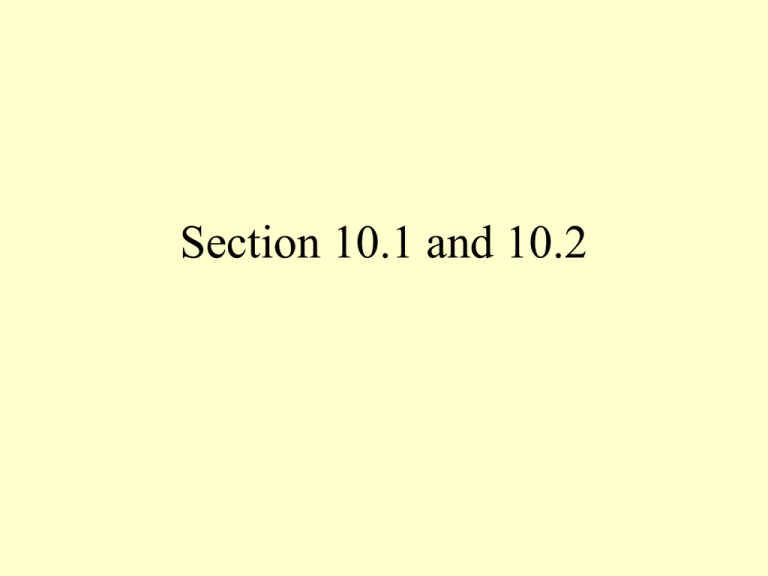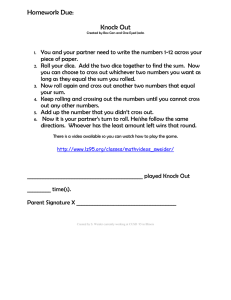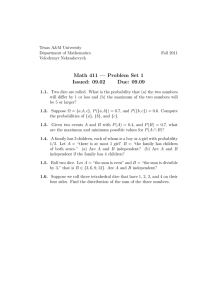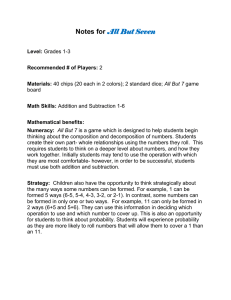Section 10.1 and 10.2
advertisement

Section 10.1 and 10.2
Hand Back Exam #3
• The class average was much better on this
exam (no adjustments necessary).
• Activity 0:
– Discuss problems 2 and 4 with your partners.
Problem #2
• Given the set A = {1, 2, 3}, what is the
value of P(A),where P denotes the power
set?
• How many elements would be in P(B) if
B = {a,b,c,d,e} ?
Problem #4
• Suppose X = {a,b} and Y={x,y}.
– Find X x Y
• How many elements would be in X x Z if
Z = {1,2,3,4,5} ?
Transition
• Both of these problems actually connect
with the material we will study for the rest
of the semester.
– Counting (and Probability)
• Counting is the basis of an entire course:
– Math 3530 Combinatorics
– Catalog description: Various ways to
enumerate elements of a set.
Activity 1
• A “Full House” in the game Yahtzee is
when you roll three dice with one number
and one dice with a second number.
Activity 1
• How many different “Full Houses” are
possible?
• In how many ways can you ROLL a Full
House with one roll of five dice?
How many different “Full
Houses” are possible?
• This one is fairly easy:
– There are six choices for the “three of a kind”
– There are five choices for the “two of a kind”
– 6*5 = 30
In how many ways can you
ROLL a Full House with one roll
of five dice?
• This is actually harder than I would expect
you to be able to do right now.
• We will come back to this one a little bit
later.
The Product Rule
• If you are finding ways to combine one
element each from a sequence of sets (one
of this AND one of this AND one of this…)
the number of combinations is the product
of the cardinality of each of the sets.
Activity #2
• License Plates in Iowa contain three letters
of the alphabet followed by three digits.
How many license plates are possible?
The Sum Rule
• If you are finding ways to select one
element each from a sequence of sets (one
of this OR one of this OR one of this…) the
number of combinations is the sum of the
cardinality of each of the sets.
Activity #3
• John has room for one more LAC class in
his schedule and he still needs to take a
course from category 1A and 1C
– 1A {ENG 1005, ENG 2015, ENG 2120} and
– 1C {CS 1025, Math 1100, Math 1420, Stat
1772, Stat 1774}
In how many ways can he select a course for
his schedule?
Activity #4
• A password on a computer system consists
of six, seven, or eight characters. Each of
these characters must be a digit or a letter of
the alphabet.
• How many possible passwords exist?
The Bijection Rule - Background
Sometimes it is hard to calculate the exact
number of elements in one set.
BUT if we can show that the given set has a
bijection with another, countable set, then we
can use that information to our advantage.
The Bijection Rule
• A function f from a set S to a set T is called
a bijection if and only if it has a well
defined inverse function.
– That is, there must also be a mapping from T to
S.
The K-to-1 Rule
• Sometimes the function isn’t one-to-one but
K-to-1.
Activity #5
• I hand out gift bags at my workshops.
There are six bags per box. Yesterday I
needed five boxes.
• How many bags did I hand out?
Activity #6
• Student ID numbers at UNI are six
consecutive digits.
– How many total ID numbers are possible?
– How many of those consist of all the same
digit?
– How many of those consist of exactly five
consecutive “same” digits (such as 122222)?



